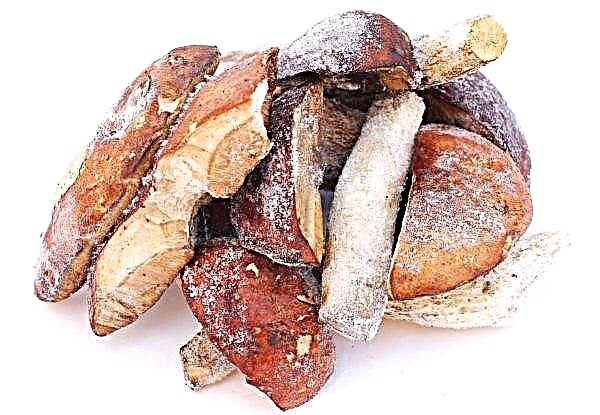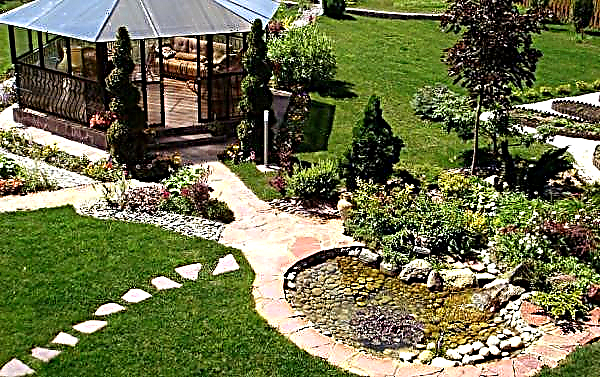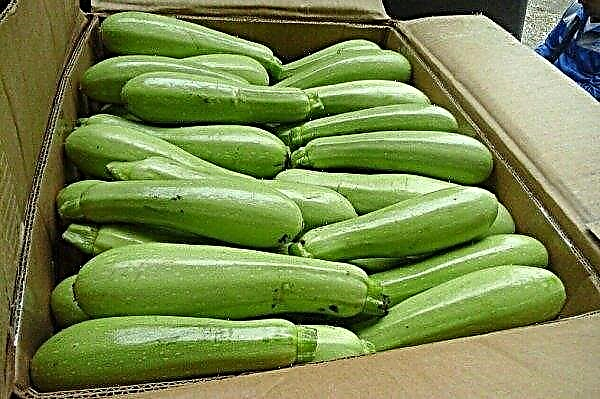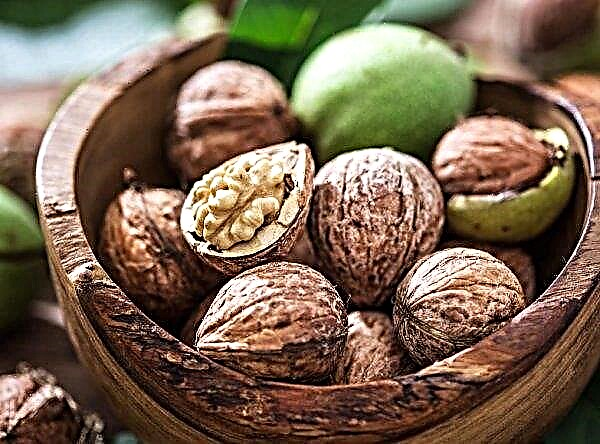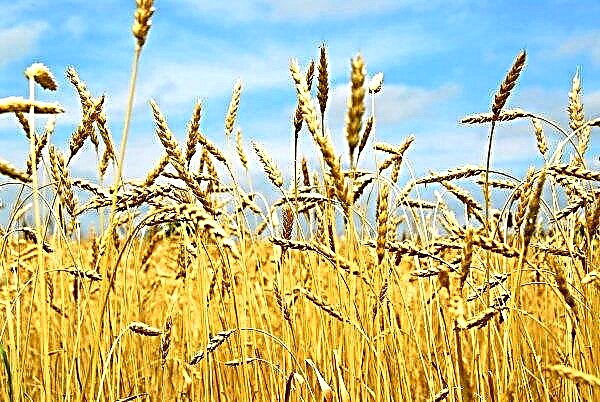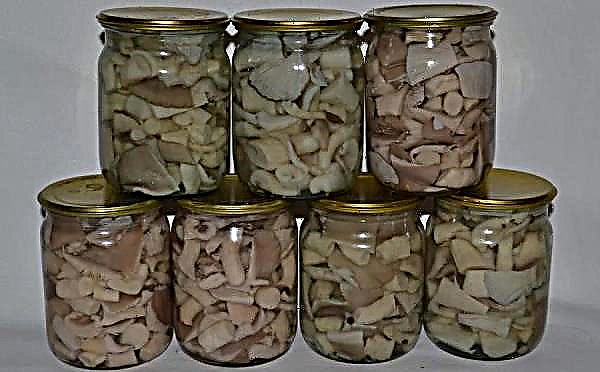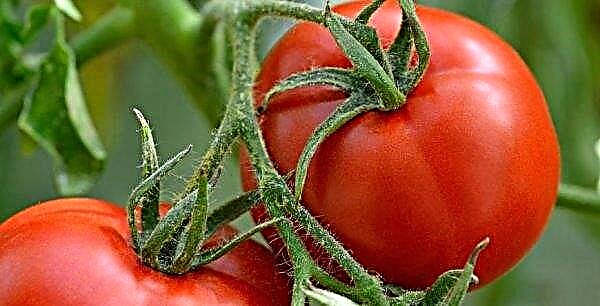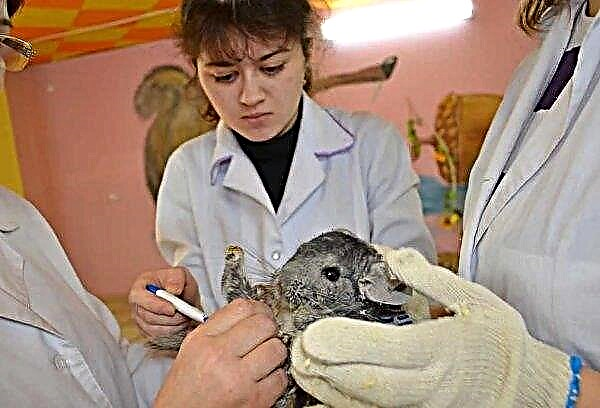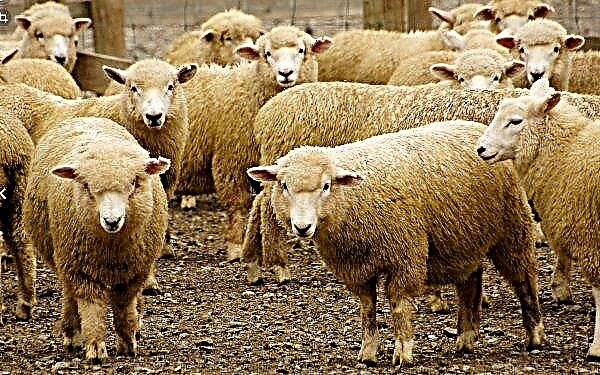The unique tropical northern rhododendron attracts many gardeners. It is distinguished by lush flowering even in the northern regions. The hybrid has bright flowers worthy to become an ornament of any garden. What is a hybrid rhododendron hybrid (Purpureum Grandiflorum) of the Finnish series, how to plant and grow it on your site, will be described further.
Botanical grade description
Rhododendron Purpureum Grandiflorum is a sprawling, evergreen shrub with a hemispherical crown. An adult plant in the northern regions grows to 1.4–1.6 m, in the southern regions it grows up to 2.5 m with a crown diameter of 2.7 m. On highly growing branches there are shiny leathery leaves of medium size (7–8 cm), oval . The top plate is dark green, the bottom is bluish. In winter, the foliage does not die off and remains green. Sometimes a brown tint may appear.
Did you know? Rhododendron is a long-lived plant. In one place, it can grow for about 100 years.
The flowers are large - 6-7 cm, with wavy edges, have no smell. Collected 12-15 pieces in compact inflorescences. They differ in a purple-lilac hue with a greenish-golden mark on the upper petal. By the end of flowering, the color fades and becomes lilac-purple.
It blooms in late May or early June, the period depends on the climatic characteristics of the area. After flowering in September - October, the hybrid rhododendron produces fruits - light brown cylindrical capsules.
Characteristics
The rhododendron shrub is a winter-hardy plant. But in the first years after planting, it is recommended to shelter it for the winter. An adult bush can withstand up to -29 ° C. Grandiflorum Purple does not have special requirements for illumination. It can grow in the sun with frequent watering, but develops better in partial shade. The shadow also tolerates, but blooms in such conditions later, and flowering does not proceed violently. The variety prefers moderately moist, fertile, well-drained soil. Long stagnation of moisture does not tolerate.
 The optimum soil acidity for shrubs is pH 4.5–5.5, but it is permissible to grow on neutral soil.
The optimum soil acidity for shrubs is pH 4.5–5.5, but it is permissible to grow on neutral soil.
In an industrial version, a finished substrate is produced, but you can independently prepare such a composition:
- peat - 3 parts;
- coniferous humus or rotted sawdust and foliage - 2 parts;
- sand - 1 part.
Did you know? Rhododendron is the largest and oldest representative of the heather family. The ancestors of this plant appeared about 50 million years ago.
Landscape design application
Evergreen rhododendron looks most effective in group free plantings. It is advisable to place the bushes on the edges of the lawn, near the tracks. Since the purple variety loves moisture, it is best to plant it near ponds, where increased humidity will create favorable conditions. Despite the fact that the bush grows quite large, it is recommended to plant at least 3 plants, between which leave a distance of 1 m.
When creating a group planting, you can not mix deciduous and evergreen varieties. In addition, having different types nearby, the height is taken into account: the highest are planted in the center, the lower ones are planted at the edges. The lilac color is well combined with coniferous plants.
 The flower looks good in a single planting. It looks especially impressive on the ground grass.
The flower looks good in a single planting. It looks especially impressive on the ground grass.
Near the rhododendron you can plant:
- spruce;
- juniper;
- pine tree;
- yew;
- thu.
Important! A sprawling bush is not suitable for rock gardens, it is better to choose lower-growing varieties.
There are many ways to use rhododendron in landscape design:
- hedge;
- heather or Japanese garden;
- rocky slides.

Landing rules
For starters, you should consider purchasing a seedling. So that the description of the variety is not fooled and the bush pleased with flowering for a long time, you need to choose the right planting material.
Important! You can not plant rhododendron next to a plant that has surface roots. This will inhibit the growth of the bush.
When choosing, adhere to such rules:
- Do not take adult specimens or rooted cuttings. They will be poorly acclimatized.
- The seedling must be 2 years old. The root system must be placed in a container.
- Healthy foliage. The sheet plate should have a greenish color and be uniformly colored. You can not take a stalk from which, upon examination, signs of necrosis were found.
 Landing is carried out both in the spring and in the summer. For the rhododendron Purple Grandiflorum, a site with diffused light is chosen. If the bush is planted near the trees, leave a distance of 2 m.
Landing is carried out both in the spring and in the summer. For the rhododendron Purple Grandiflorum, a site with diffused light is chosen. If the bush is planted near the trees, leave a distance of 2 m.
Good neighbors would be:
- spruce;
- larch;
- Pine.
If groundwater lies close to the surface, it is best to land on an earthen hill, overlaying it with stones. After the acquisition, the seedling is lowered by the rhizome into a bucket of water and held until bubbles begin to form. Then, in the prepared hole, a recess is made according to the size of the roots and the bush is carefully placed there. Work is carried out carefully so as not to damage the rhizome. They are covered with earth from above, lightly tamped, watered and mulched with needles.
 Prepare a landing pit in advance, for 3-4 weeks. Since the root system of the rhododendron is superficial, he does not need a deep pit. Its approximate dimensions: diameter - 0.6 m, depth - 0.4 m. The dug recess is filled with the prepared substrate.
Prepare a landing pit in advance, for 3-4 weeks. Since the root system of the rhododendron is superficial, he does not need a deep pit. Its approximate dimensions: diameter - 0.6 m, depth - 0.4 m. The dug recess is filled with the prepared substrate.
Care Features
In order for the rhododendron to grow successfully and be able to flourish, he needs to arrange care. One of the mandatory procedures for caring for the bush is mulching.
Mulch is used for:
- preservation of moisture in the soil;
- protect the root system from aggressive sun;
- obstacles to the growth and spread of weeds;
- protect the roots from freezing.
Did you know? There are species of rhododendron that bloom before foliage: Japanese, Schlippenbach and Ledebour.
Peat, shredded bark or pine needles are used as mulch. They are poured with a layer of 8 cm. The crown will always be healthy, and the inflorescence will be magnificent if the correct watering regimen is applied. Rhododendrons love moisture, but do not tolerate its stagnation. In the dry period, the bushes are watered 3 times in 7-10 days. Norm - 10 l under the bush. Young low plants require less moisture - 5 liters. Since rhododendron loves acidic soil, water can be acidified before watering.

To do this, you can use (based on a bucket of water):
- concentrated sulfuric acid - 1 ml;
- citric acid - 3-4 g;
- table vinegar - 100 ml.
Important! Removing inflorescences in young bushes causes the appearance of new shoots and the growth of the bush.
Fertilize rhododendron 2-3 times:
- In the spring. Use compost in the amount of 1 bucket under a bush or full mineral top dressing (30–40 g per 1 m²).
- After flowering for laying buds for next season. Suitable phosphorus-potassium fertilizers (ratio 2: 1).
Chlorine and lime dressings are not suitable for the Grandiflorum Purpureum variety. After the bush fades, it is necessary to collect faded inflorescences. Because of this, the seeds do not form, but the plant can use all the forces to lay new flower buds.
Pruning of rhododendron is carried out only with the aim of forming a crown. Perform work immediately after flowering. June is the period when you can remove extra root shoots or long branches.

Rhododendron may be frost-resistant, but young bushes should still be sheltered for the winter. After the first frosts, the plants are wrapped in burlap or other material by tying the branches with a rope. Remove shelter after winter, as soon as the snow melts. The variety Grandiflorum Purpureum does not have specific diseases and pests. But it can be subject to standard gardening problems. Especially the plant is vulnerable to improper care.
Did you know? There are poisonous species of rhododendron. For example, in yellow all parts are poisonous.
To maintain the health of the bush, such activities are carried out:
- Fungal diseases. In the spring, after warming up the temperature to + 5 ° C, the bushes and the soil around them are treated with fungicidal preparations. After 10-14 days, the procedure is repeated.
- Metabolic and iron deficiency (chlorosis). It manifests itself as spots that form on a leaf plate. Treatment and prevention is carried out with iron-based drugs.
- Malicious insects. They get rid of them by treating the bush with insecticidal and acaricidal drugs. From slugs and snails use "Thunderstorm".

Breeding methods
The hybrid Grandiflorum Purpureum can be propagated by seeds or vegetatively. Cuttings can be harvested from semi-lignified branches from mid-June. The shoot is cut 5–8 cm long, foliage is removed on the lower part, and 2–3 pieces are left on the top. Since the cuttings are poorly rooted, it is recommended that they stand 12-16 hours in the growth stimulant solution before planting.
Cuttings are planted in a container with a moist sand and peat substrate. The plant will take root in 3-5 months. In winter, the seedlings are placed in a cool, bright room, and in the open ground they grow 1-2 years.

The seed method is more time consuming. First of all, the seed is stratified (1-2 months are kept in wet sand at a temperature of + 1 ... + 5 ° C). Before sowing, the seeds are washed and soaked for 8-12 hours in a growth promoter. Seedlings are grown in a substrate of peat and sand. Shoots appear after 6-8 days. After that, the seedlings are provided with sufficient light and air temperature + 15 ... + 20 ° C.
Important! The first year, seedlings grown from seeds are kept in greenhouse conditions.
The easiest way is reproduction by layering. Near the mother bush in the spring, make a small depression in which a nutrient substrate is introduced. On a young shoot, cuts are made in several places, foliage is removed into parts that will be placed in the ground, carefully tilted and placed in the hole. Using staples or hooks, the layers are secured and sprinkled with a substrate.
Throughout the season, the soil must be moistened and, if necessary, added. By mid-summer, you can see the first signs of rooting. You can only plant it from the mother plant next spring. Re-use the mother bush for layering is possible only after 5-10 years.
Rhododendron Grandiflorum Purpureum is an amazing plant that is well cultivated even in adverse climatic conditions. With minimal care and proper planting, you can get a magnificent lush shrub in the garden.

